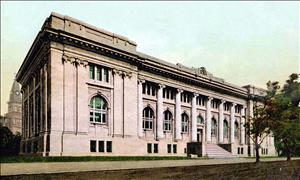On June 14, 1943, King County Rural Library District and The Seattle Public Library enter into a contract that allows library district patrons to utilize all services of The Seattle Public Library. The contract becomes effective on September 1, 1943, giving residents of rural King County the immediate opportunity to access the collection of what is at the time the largest public library in the Pacific Northwest.
For Rural Readers
The contractual agreement closely followed the establishment of the King County Rural Library District on January 4, 1943. The Rural Library District was created to provide library services to King County residents in rural areas, who lack access to existing libraries.
The contract between the two library systems was a huge boon for King County residents outside Seattle, since it would take years for King County Library to build its own collection.
A Close Alliance
Judson T. Jennings (1873-1948) chaired the five-member King County Rural Library board. Jennings had recently retired from a long tenure as head librarian at The Seattle Public Library, and almost certainly forged strong ties between the two systems in King County Library's earliest days.
Trustees of The Seattle Public Library agreed unanimously to the contract, which was read into the minutes at their June 8, 1943, meeting. In addition to spelling out the details of book services, the contract stipulated that the head librarian at The Seattle Public Library was to hire (with King County Library board approval) the county librarian. Ella McDowell, a Seattle Public Library reference librarian for the previous 12 years, got the job. (The hiring oversight clause in the library services contract remained in effect until 1962).
A Valuable Asset
King County Rural Library District’s first annual report, covering 1943-1944, stated:
“This contract has been and will continue to be one of the most valuable assets of the county library. The close association provided for assures wise parallel development ... . Since [September 1, 1943], 913 individuals have registered to borrow directly from the Seattle Public Library or its branches and they have borrowed 12,313 books. In addition, the King County Library staff has borrowed 1,388 books to fill specific requests” (p. 3).
The 1947 annual report called the reciprocal agreement between the two library systems “one of the most valued services of the King County Public Library” (p. 3).
King County Rural Library District, meanwhile, was charged with using its own separate budget to develop its own book collection for use throughout the county outside Seattle city limits. King County Library staff began ordering new books that would form this collection. Doris Hopkins, a Seattle Public Library staff member, was given a six-month leave of absence to help King County select books to order.
Financial Compensation
Payment by the county library system for the service was initially based on the current per capita cost of circulation. In 1947, this became an annual flat fee of $10,000 per year (subsequently adjusted over the years). “The value of this contract cannot be measured in money,” the 1947 King County Library annual report stated. “One could not set a value on the privilege of borrowing a book that is unobtainable on the market nor the importance of a pooled film and record collection, nor can one measure the numerous services that are gladly given” (p. 3).
By 1979, King County Library System was paying The Seattle Public Library $100,000 per year to absorb the cost of providing library services to non-Seattle King County residents.
A Slow Shift
Seattle residents, meanwhile, had reciprocal access to the books and services of the King County Library System. As King County Library’s collection and facilities increased over the decades, the balance of how library patrons utilized these services shifted between the two library systems, from the early days when The Seattle Public Library had been more heavily utilized by non-Seattle residents, to a shift whereby Seattle residents leaned more heavily upon the services of King County Libraries, including utilizing the online catalog to place holds for titles not available through The Seattle Public Library’s catalog.
In 2003, The Seattle Public Library began reimbursing King County Library System $104,000 annually to cover losses caused by the imbalance in reciprocal use between the two systems. In 2006, a study of the King County Library System revealed that Seattle residents used the King County Library System more frequently than King County residents living outside Seattle used The Seattle Public Library to an even greater extent than had been previously understood, resulting in an actual net loss of $927,078 to King County Library System.
Seattle residents are not taxed to fund the King County Library System. King County residents living outside Seattle city limits fund the King County Library System via property taxes. The Seattle Public Library is funded by the City of Seattle.
Holds Barred
On May 30, 2006, King County Library System trustees voted unanimously to rescind Seattleites' privilege of placing King County Library books on hold. On June 22, 2006, trustees of The Seattle Public Library also voted to modify the agreement between the two organizations, citing an inability to increase its payments to the county system.
As of 2011, Seattle residents retain the right to hold borrowers cards from King County Library System, including book borrowing, access to databases, and all other library services except placing books on hold. King County residents living outside Seattle city limits retain full privileges at The Seattle Public Library, including placing books on hold.

